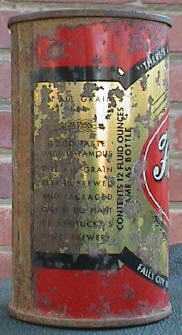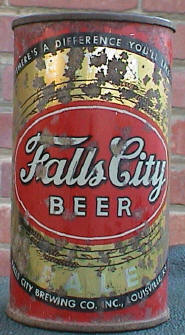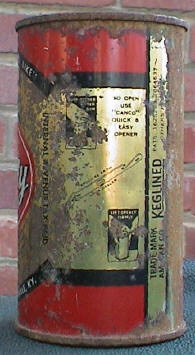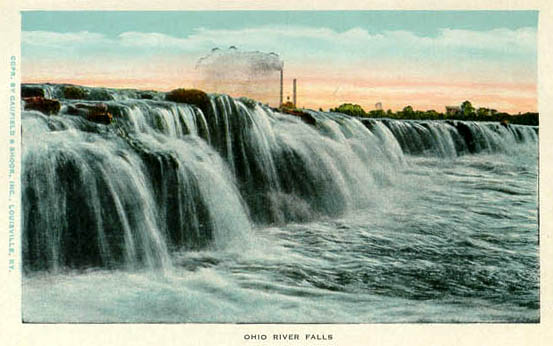Falls City Beer: Circa 1940
 |
 |
 |
This isn't a rare can, but I dumped a lot of Falls City cans when I was a teenager in the 1970s so I like the brand. This is their first Opening Instruction (OI) can from about 1940. I like the colors and the design so it gets to be my May Can-of-the-month! It can be very hard to read, but it has the words "EXTRA PALE" in white letters in the gold on front. You can read the "PALE" fairly well in the photo above showing the can's front.
Falls City Brewing 1905-1978
Falls City began as a reaction to the consolidation of Louisville's breweries which began in 1901 when Fehr's Brewing and four other of the city's breweries joined to form the Central Consumer's Company. The new conglomerate not only formed an exceptionally large brewing concern, but they also controlled most of Louisville's prime saloon locations. In 1905 several Louisville businessmen joined together to form their own brewery to compete. They started visiting the local saloonkeepers to find enough backers and soon had 150 new stockholders. They began producing a small amount of beer
The original stockholder's meeting was held in Delaware on April 17, 1905. (By chance, I started typing this account on April 17, 2005, the 100th Anniversary. Cue Twilight Zone music.) The company was organized under Delaware laws, probably to take advantage of tax laws there. In May 1905 the first Board of Directors meeting was held. In July 1905 the Board picked a spot to build the brewery at 30th and Broadway in Louisville next to the Southern Railroad. They then hired Otto Doerr, the brewmaster at the Schaffer-Meyer Brewery. Interestingly, the Schaffer-Meyer Brewery was part of the Central Consumer's Company that the Falls City Brewery was being organized to compete against. That raises the question, why did Doerr in effect switch sides? Was it simply a money decision? He was promised a $3,500 a year salary plus 10 cents a barrel for each barrel over 35,000 produced in a year. Or did he resent the domination of the CCC by Fehr's? Brewmasters generally were the most critical employee in a brewery. If Doerr was used to being the main figure at his brewery it may have grated on him to find himself playing a lesser role to Fehr's brewmaster in the combined company. (Of course this assumes that Fehr's brewmaster took the lead role in the Central Consumer's Company.) Or was it something else entirely? Unfortunately, Doerr's motivation remains unknown. He did help supervise the construction of the new brewery in 1905 and it had an initial capacity of 75,000 barrels a year. On November 17, 1906 Falls City's first draft beer was sold to local saloons and a bottling house was planned. The brewery expanded its plant in 1907 and bottled beer was first sold in 1908. They also were selling ice, a business that would be useful during Prohibition.
A Falls City brewery truck in the 1910s.
Falls City struggled at first and the Central Consumer's Company unsuccessfully tried to buy them out in 1911. Not all of the saloonkeepers who bought stock in Falls City purchased the brewery's products; some bought a cheaper beer. Some of Falls City's affiliated saloons were themselves bought out by the Central Consumer's Company and then carried that brewery's products. Still, Falls City slowly grew and by 1912 was producing between 50-100,000 barrels a year. By 1919 Falls City was making enough of a profit that they were able to pay off all of the stockholders when Prohibition started.
Prohibition
Falls City was sold in April 1919. However, a new company was formed later that year, the Falls City Ice and Beverage Company. In July 1919 the new company bought the brewery from the man who had purchased it in April and began to sell ice, soft drinks, and near beers called Falls City Special Lager and Special Pale. It lost money in 1920 but in 1921 showed a profit, and remained profitable throughout Prohibition. In 1927 Hans Baur, a brewmaster from Augsburg, Bavaria, replaced Otto Doerr as brewmaster. The brewery continued and their success during these years would prove helpful after Prohibition was lifted in 1933, because the brewery had maintained its equipment as well as a level of expertise. Also, customers were familiar with the company name. Moreover, Falls City had built up a cadre of loyal and experienced distributors who would be willing and able to sell their "real" beer where other breweries would be scrambling to set up a distribution network.
Post-Prohibition
In April 1933 Falls City began producing 3.2% beer. There was an enormous market trying to get their product, but the brewery decided to first take care of the distributors who had remained loyal to the product during Prohibition. As production increased new distributors were added and the brewery had expanded outside Kentucky and Indiana to sell also in Illinois, Ohio, West Virginia, North Carolina, Georgia, Alabama, and Virginia. (Note; I've never dumped a Falls City can in Virginia, so I suspect its sales were limited to the southwest corner of the state, an area I have yet to dump.) Increased demand meant increased production and the brewery added numerous improvements during the 1930s. By the late 30s they could produce more than 500,000 barrels a year and their bottling line could fill 400,000 bottles in an 8 hour shift. In 1940 they finally started canning their Extra Pale, starting on Derby Day (the first Saturday in May) of that year. The can of the month is an Extra Pale from this period. Falls City Extra Pale was the only brand they canned, but after World War II they dropped the "Extra Pale" and just called it "Falls City Beer." Canned beer accounted for only about 15% of their total sales by World War II, but they did can some for the armed forces in World War II. The olive drab cans are now very rare and only a small handful still exist in collections.
The Falls City Brewery, late 1930s.
Falls City started canning beer again for civilian use in 1947 and ran 3 bottling lines and 1 canning line. Falls City used only flattop cans. Unlike their Louisville rivals Fehr's and Oertels, they never used cone tops. They changed the can design in the early 1950s, finally abandoning the Opening Instruction (OIs) cans long after most other breweries had done so. The new design used a large white oval instead of the gold one and remained the design until about 1972, when they switched to aluminum cans, one of the earliest brewers to do so. In abut 1976 they switched to a white can, but this design was short-lived. The did, however, experiment with the Sta-Tab opening which replaced the pull tab.
Rival brewer Fehr's closed in 1964 and Oertels in 1967. Falls City as well was facing pressure from the big national breweries. The chairman of the board at that time was Lillian Madden, who had started as a secretary in 1916, and worked her way up through the corporation until becoming President in 1950 and Chairman of the Board in 1964. Sales peaked in 1969-1970 at a bit over 750,000 barrels a year. In 1973 Fall City introduced a new brand, Drummond Bros. Preferred Beer. The light beer was designed to appeal to customers in their 20s and early 30s. The name was the result of market testing groups held with students from the University of Louisville. The brand was never a big seller, but it was produced until the brewery closed in 1978.
Falls City was the first brewer to try the Sta Tab opener to replace the pull tab. The Sta Tab can was introduced in late 1975 (see my September COM for more).Billy Beer
In late 1977 Falls City was one of several small breweries to try making and selling Billy Beer, named after President Carter's brother, Billy. Billy Carter had become the arch typical beer drinking good ol' boy in the press and some marketers decided to capitalize on his name by making a beer that supposedly he picked as the best. In reality, Billy Carter thought Billy Beer was awful, and he stuck to his favorite, Pabst Blue Ribbon. Nonetheless, there was an aggressive marketing campaign and rumors started that Billy Beer was somehow "rare." In reality, there were at least 2 billion cans produced by the 4 different breweries that made Billy Beer, and many of the cans were stored away by collectors and others who had heard the rumor. As a result, they are a very common can today, and worthless to collectors. (see my Billy Beer Page).
Billy Beer, meant to be the savior of Falls City, was a total flop. By late 1978 it accounted for only 1% of their production, and maybe even less of their sales. Also, for the first time, Falls City was showing a loss and the managers decided to shut it down. The brewery could not be sold, but the rights to the labels were bought by Heileman Breweries, which was buying small breweries around the country and taking over the old brand names. Falls City was made in Evansville, Indiana for awhile at the old Sterling Brewery. The brewery equipment at Falls City was bought by a Hong Kong company and shipped overseas. Most of the building are now gone, but the bottling shop still stood as of 1995. (Is it still standing?)
Dumping Falls City, a Personal Account
As a teenager in 1977 I was visiting my grandparents in Campbellsville, Kentucky. My family then still owned Clay Hill Farm north of the town (sometimes called "Dr. White's place.") My Mom had spent her summers there in the late 1930s with her grandparents, her sister and assorted cousins. She told me that she remembered her grandfather, Dr. White, going out at night to scare away the teenagers who would park in the woods up the road from the house, drinking beer and making out. My mom thought there might still be cans lying around at the old pull off. So my folks and I got some bags and drove up to the pull off in the woods and WOW, there were cans everywhere. I found Fehr's, Sterlings, Falls City, Oertels, black Miller cans, flats and cones and crowntainers and early pull tabs, (I guess young lovers were still parking there as late as the early 1960s). Across the road there were even more cans including Burger cones from Cincinnati and painted Sterling bottles. I took back several huge trash bags full of the cans, and they traded like crazy at can shows in Ohio.
I went back a couple of years ago to see what I could find. There was no trace of the old pull off, it was completely overgrown, and the cans were long gone. Even with a metal detectors I could only find a few crushed bits and pieces. The area across the road belongs to Campbellsville University now and there were still cans there, mostly Sterlings and Falls City. Still, I have a fondness for this brand because I dumped so many as a kid at this spot.
Why Falls City?
Why the name "Falls City"? The beer took its name from Louisville's nickname, "the falls city." According to the Speed Museum in Louisville, "The Falls of the Ohio, a series of rocky rapids, were an obstacle to boats trying to go up or down the river. Boats going down river had to unload at Louisville, carry their cargo and passengers overland, and reload at Shipping port or Portland for the rest of the journey west. It was expensive and inconvenient for travelers, but provided work for many people in the Falls towns."
The Ohio Falls.
The Ohio Falls are at a Devonian Period fossil coral reef. There is an Indiana State Park there now.Name Changes
Falls City Brewing Company 1905-1918
Falls City Ice and Beverage Company 1918-1933
Falls City Brewing Company 1933-1978
(aka Drummond Bros. Brewing Company 1970s)
Falls City Brands
Pre-Prohibiton
Peerless
Extra Pale
Salvator (dark beer)
Life Saver
Prohibition (Near Beer)
Falls City Special Lager
Falls City Special Pale
Post-Prohibition
Extra Pale
Falls City Lager
Falls City Bock
Falls City Ale
Falls City Dark
Hi-Bru
Billy
Drummond Bros.
(If I left any brands off this list please let me know. Thanks, Mark)
Please note, I found much of this information in Louisville Breweries. If you are interested in Louisville brewing history I can not recommend this book enough!
Brands Canned by Falls City Brewing
Falls City (1940-1979)
Drummond Brothers (1970s)
Billy Beer (1978-79)
Sources Used:
Beer Can Collectors of America. United States Beer Cans. (Beer Can Collectors of America: Fenton, Mo) .
Beer Can Collectors of America. Catalog of American Beer Cans. (1993).
"Falls City: Its History-Its Plant-Its Policy" Brewery Age (November 1939) 42-50.
Falstaff Brewing: includes history of several breweries.
Guetig, Peter R. and Conrad D. Selle. Louisville Breweries: A History of the Brewing Industry in Louisville, Kentucky New Albany and Jeffersonville, Indiana. (Mark Skaggs Press, 1995) 218-242.
Van Wieren, Dale P. American Breweries II (West Point, PA.: East Coast Breweriana Association, 1995).

